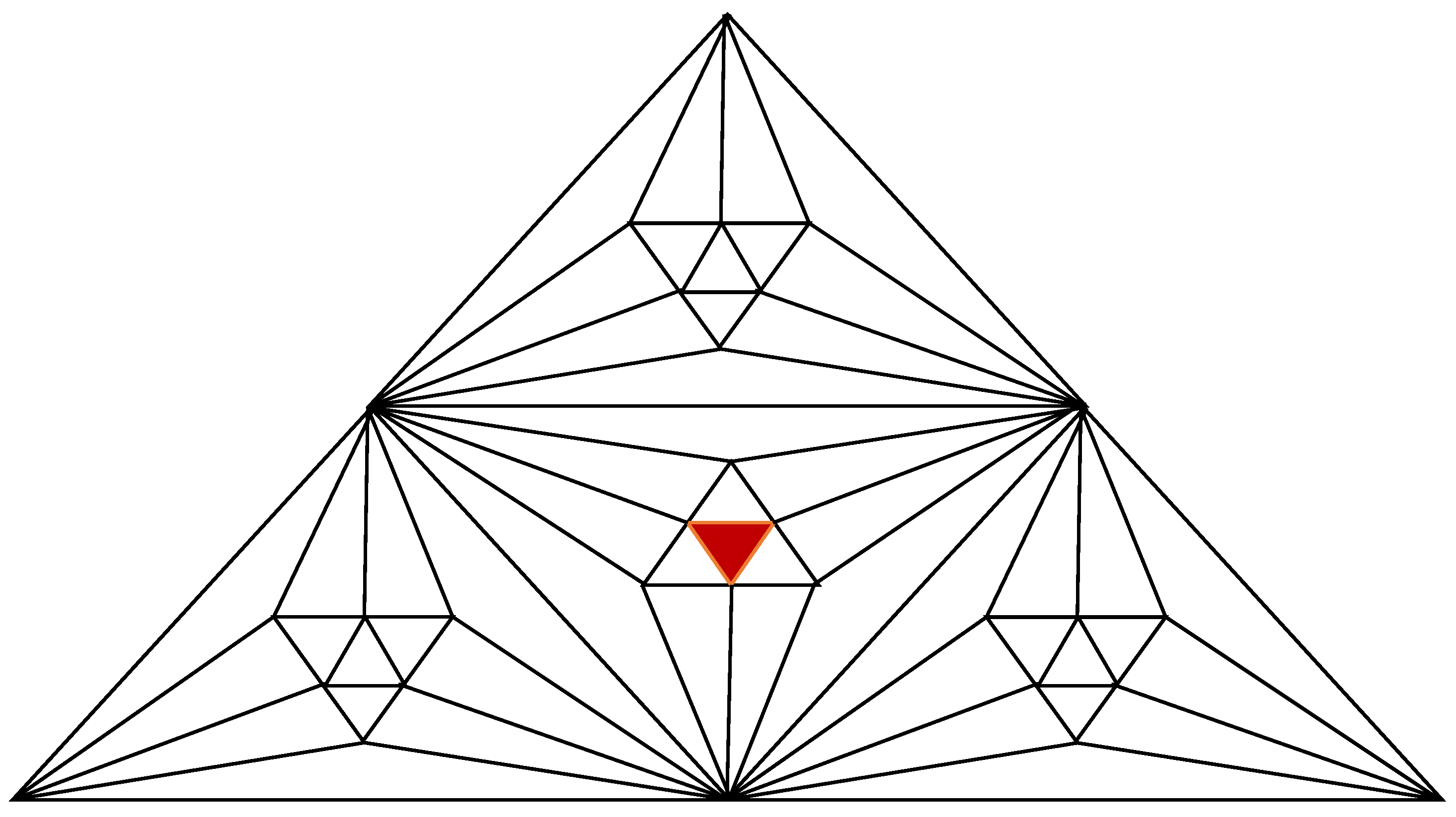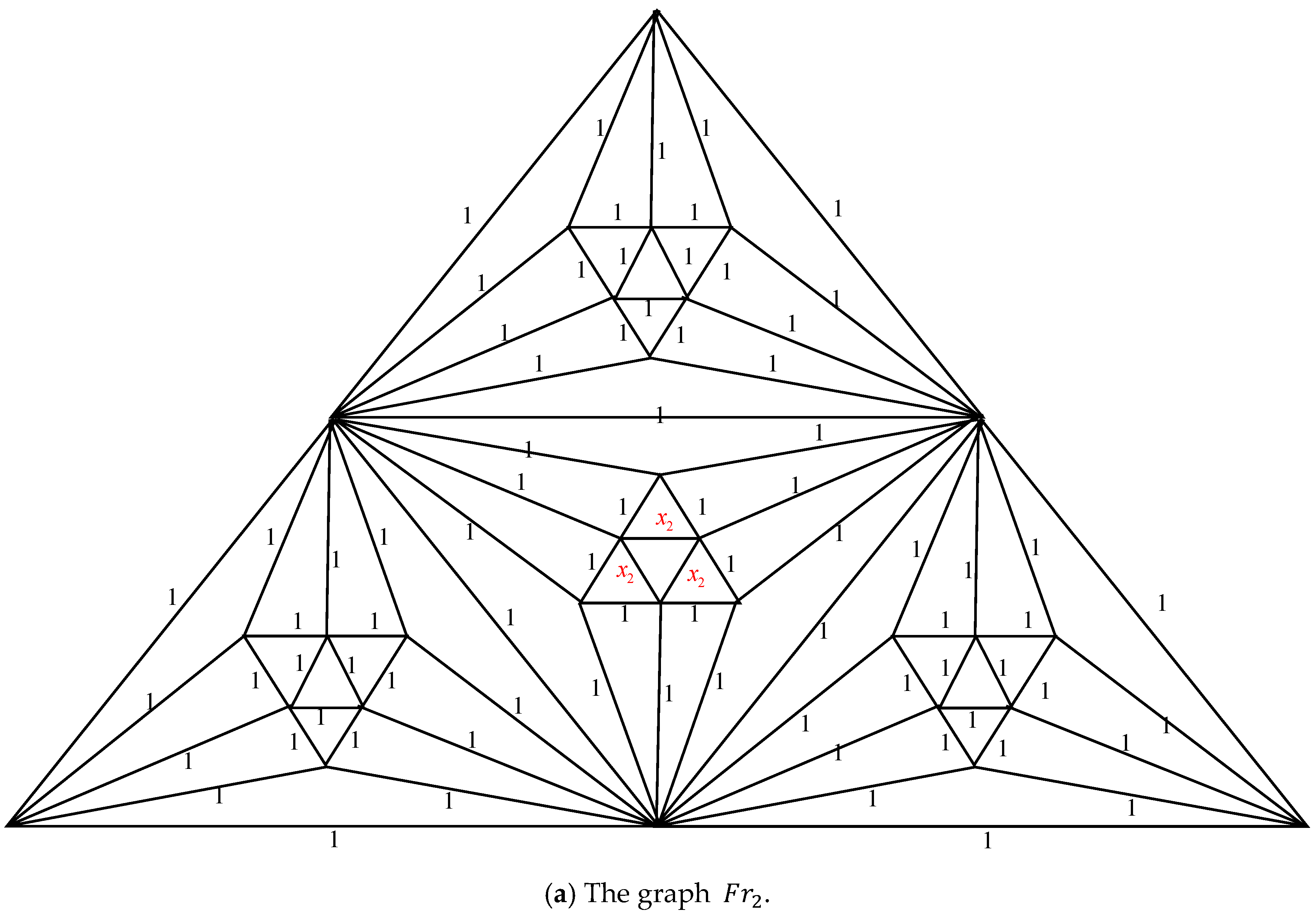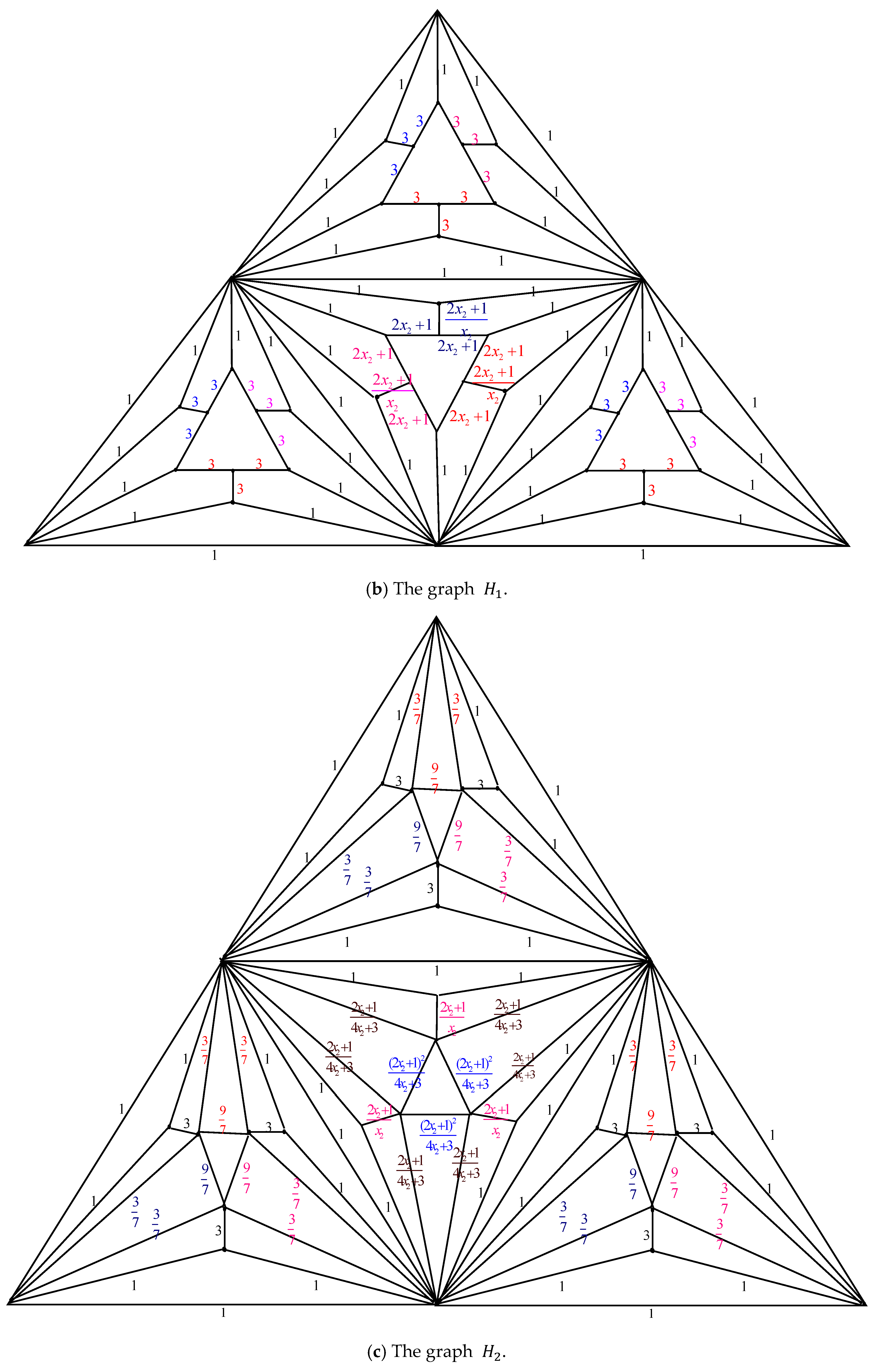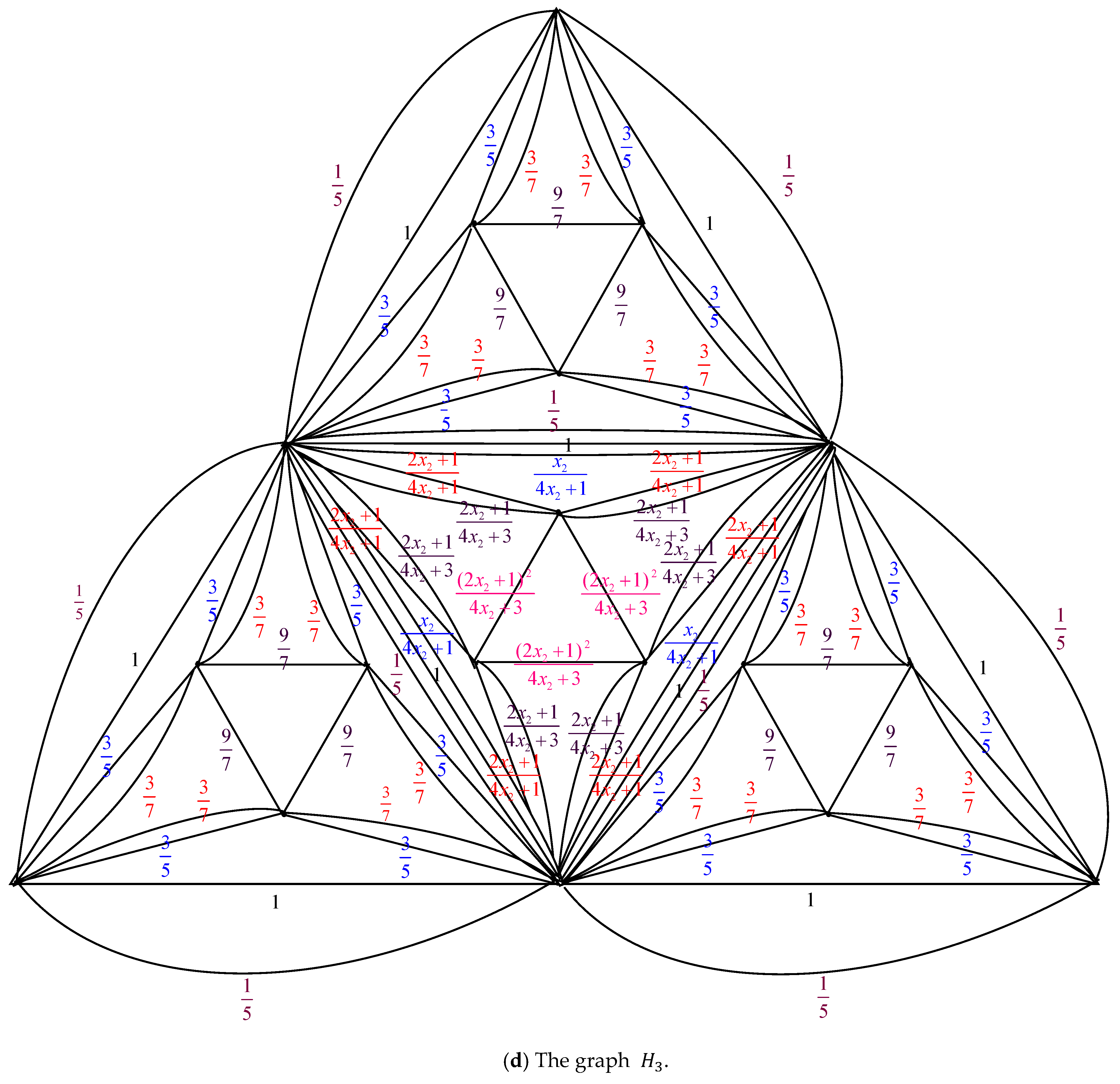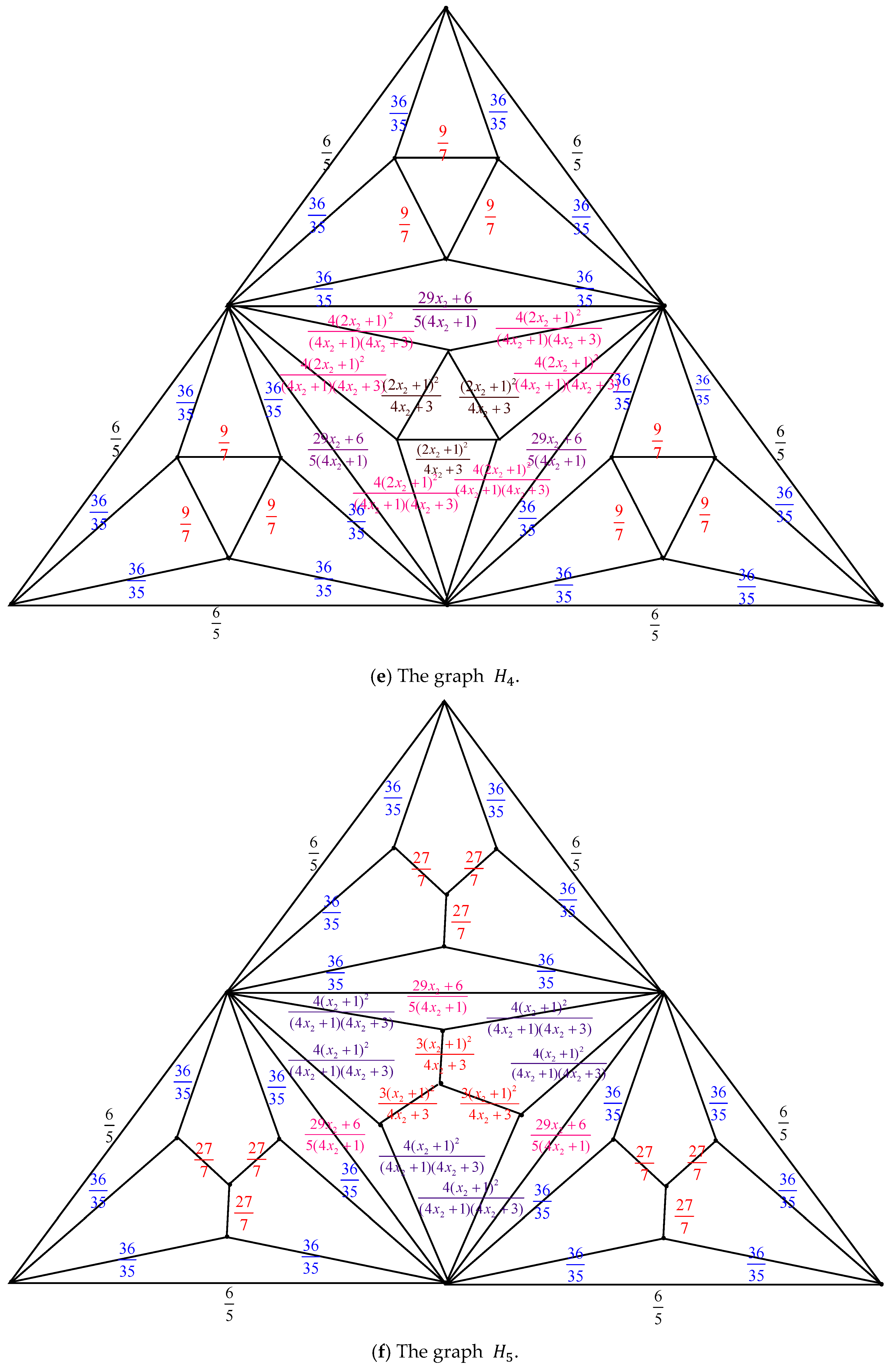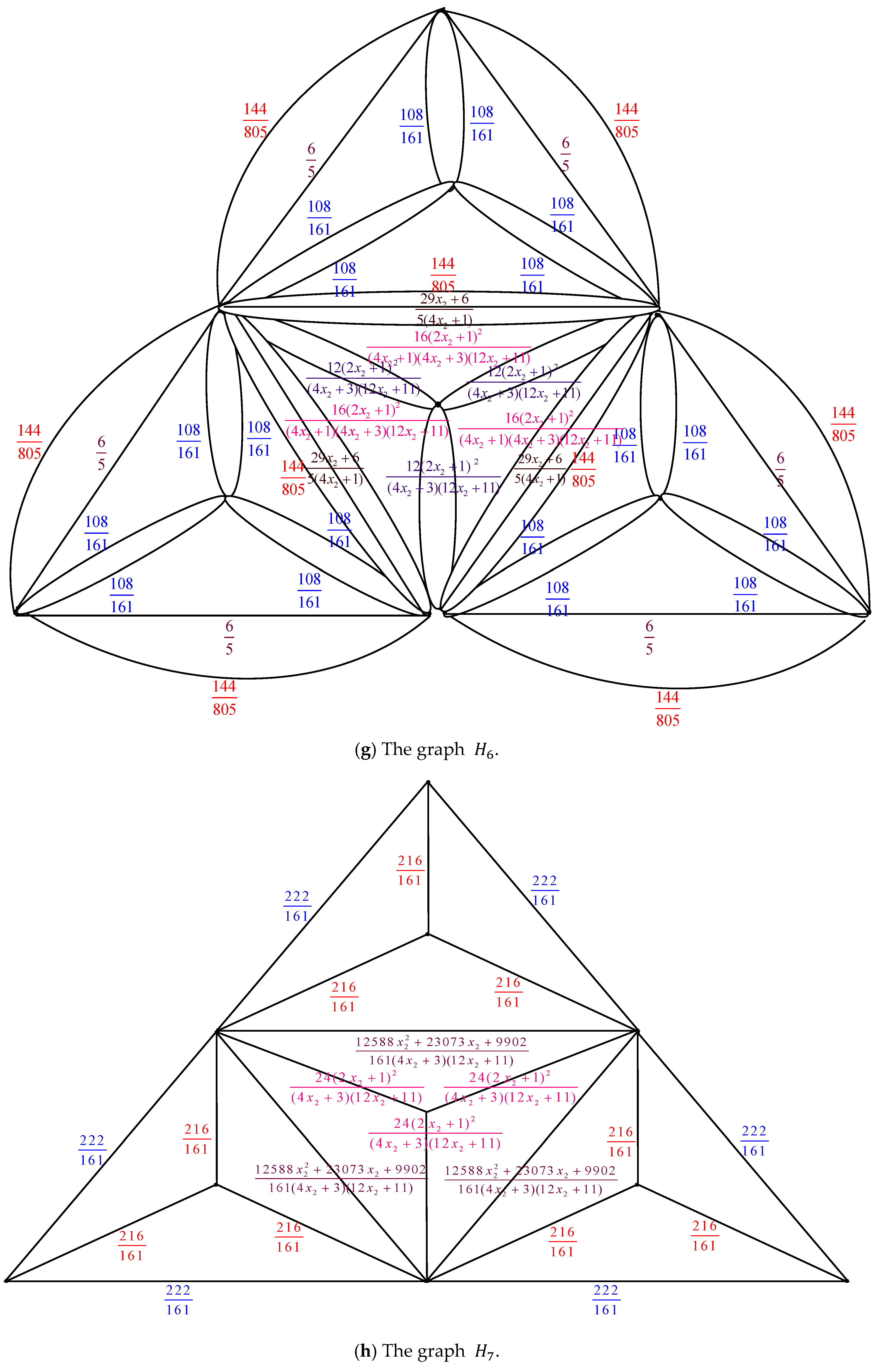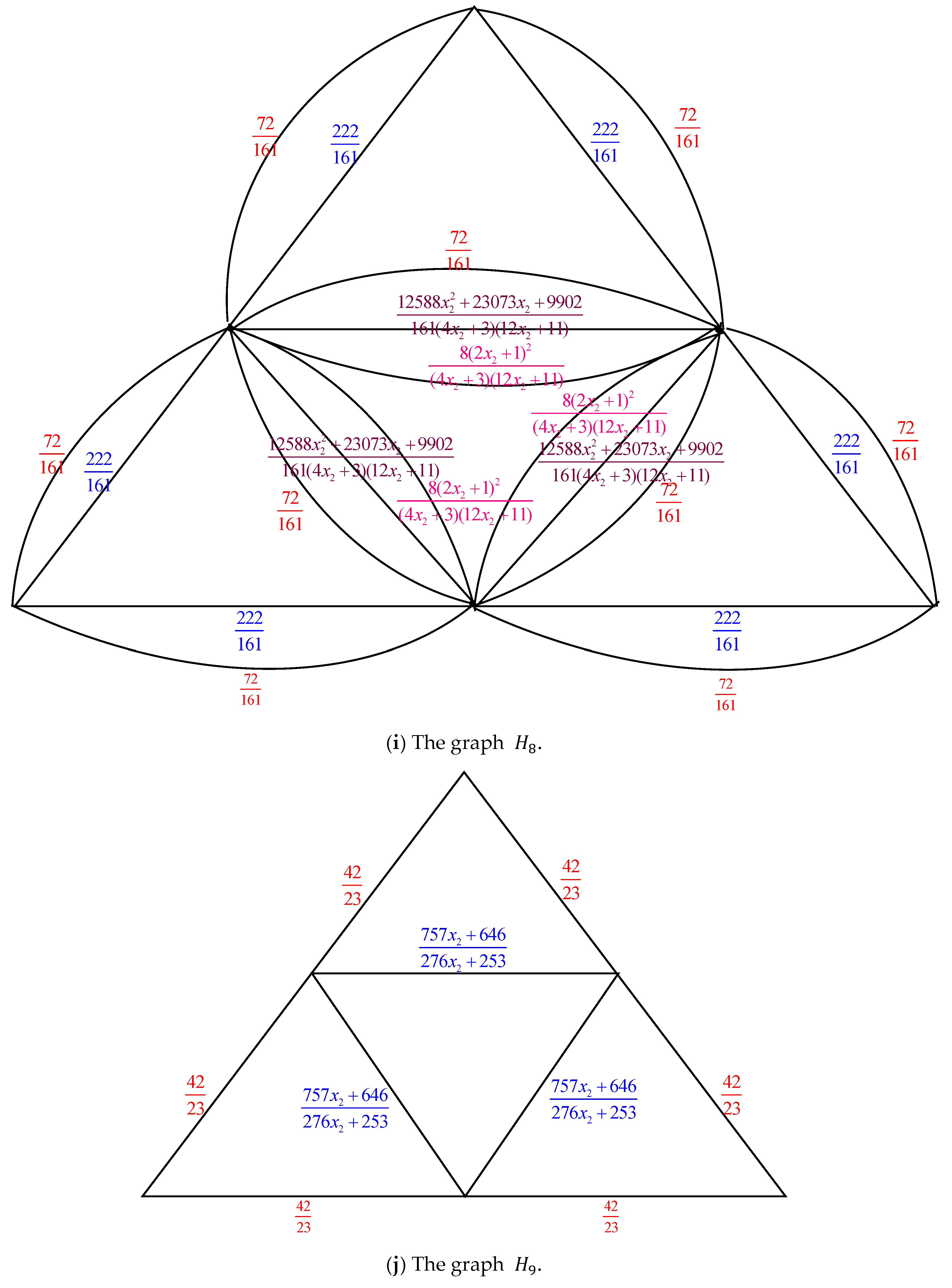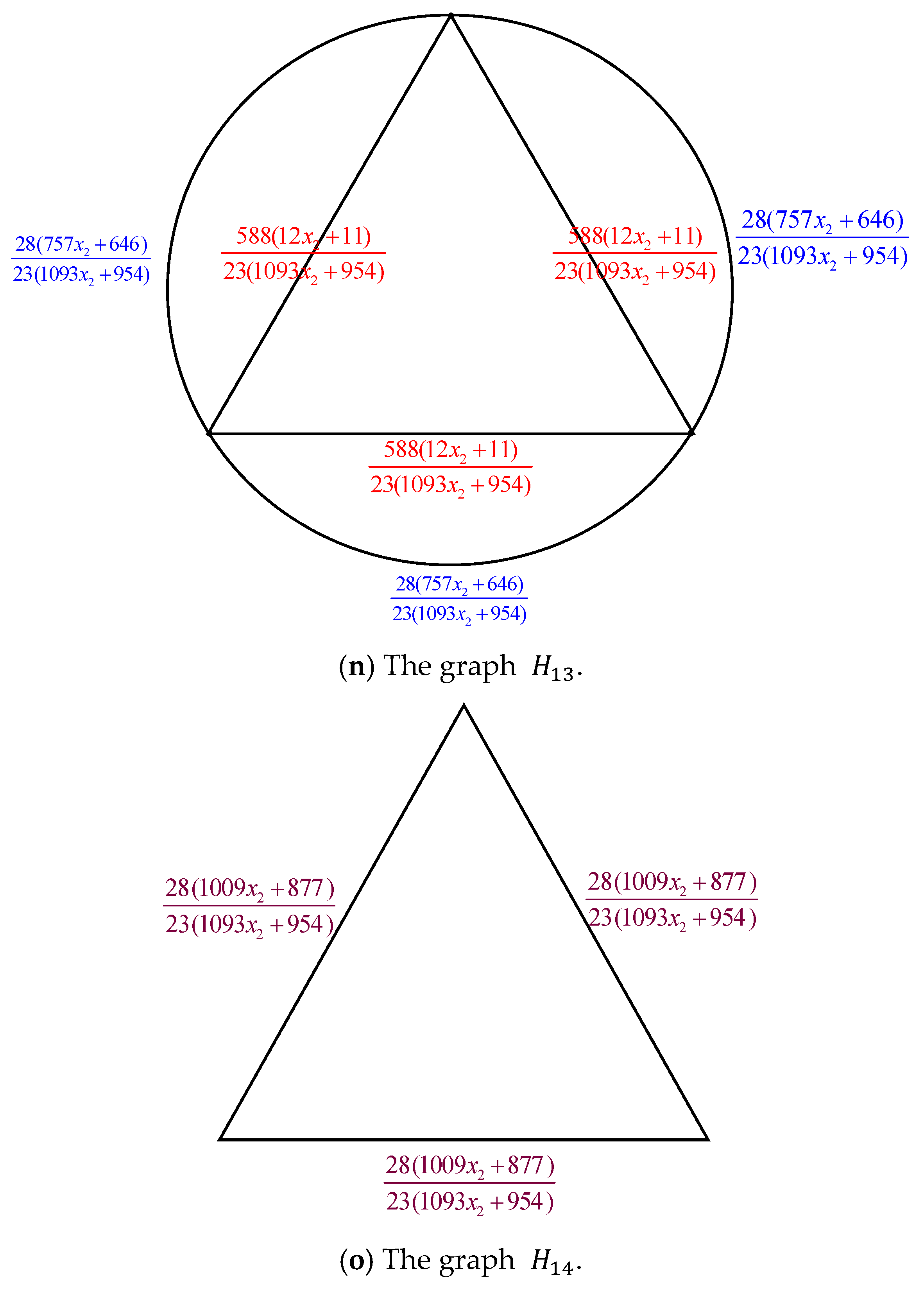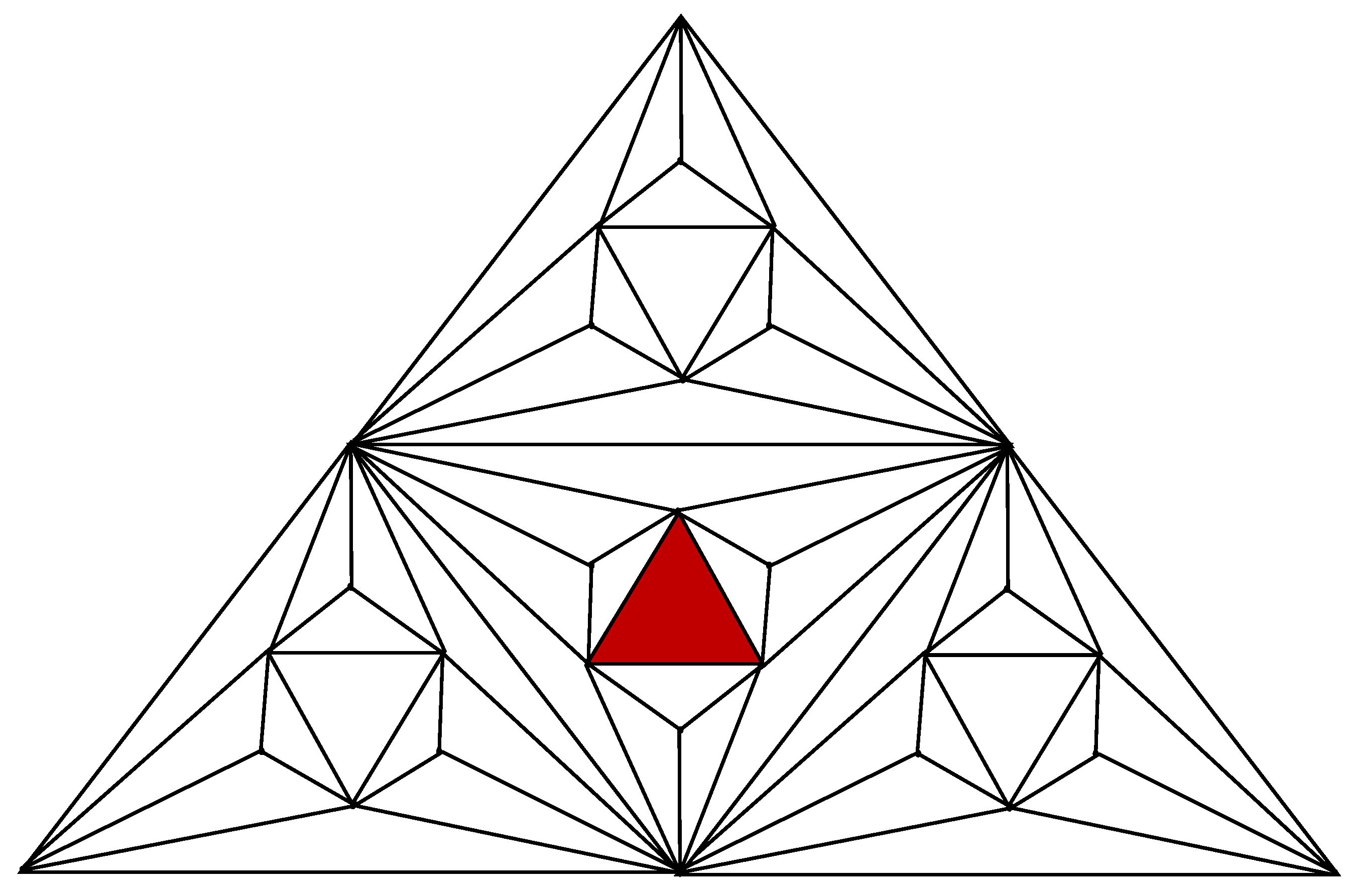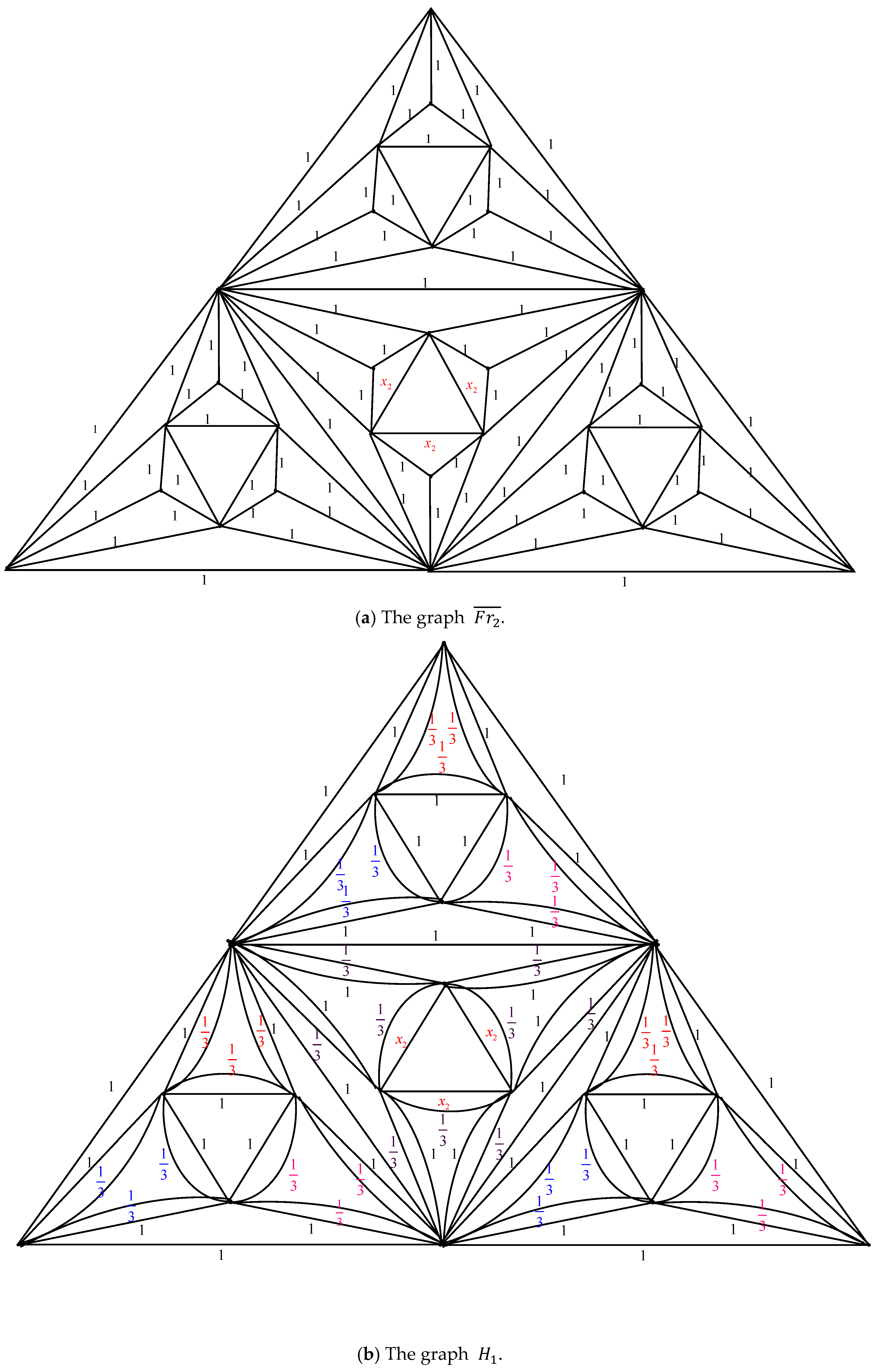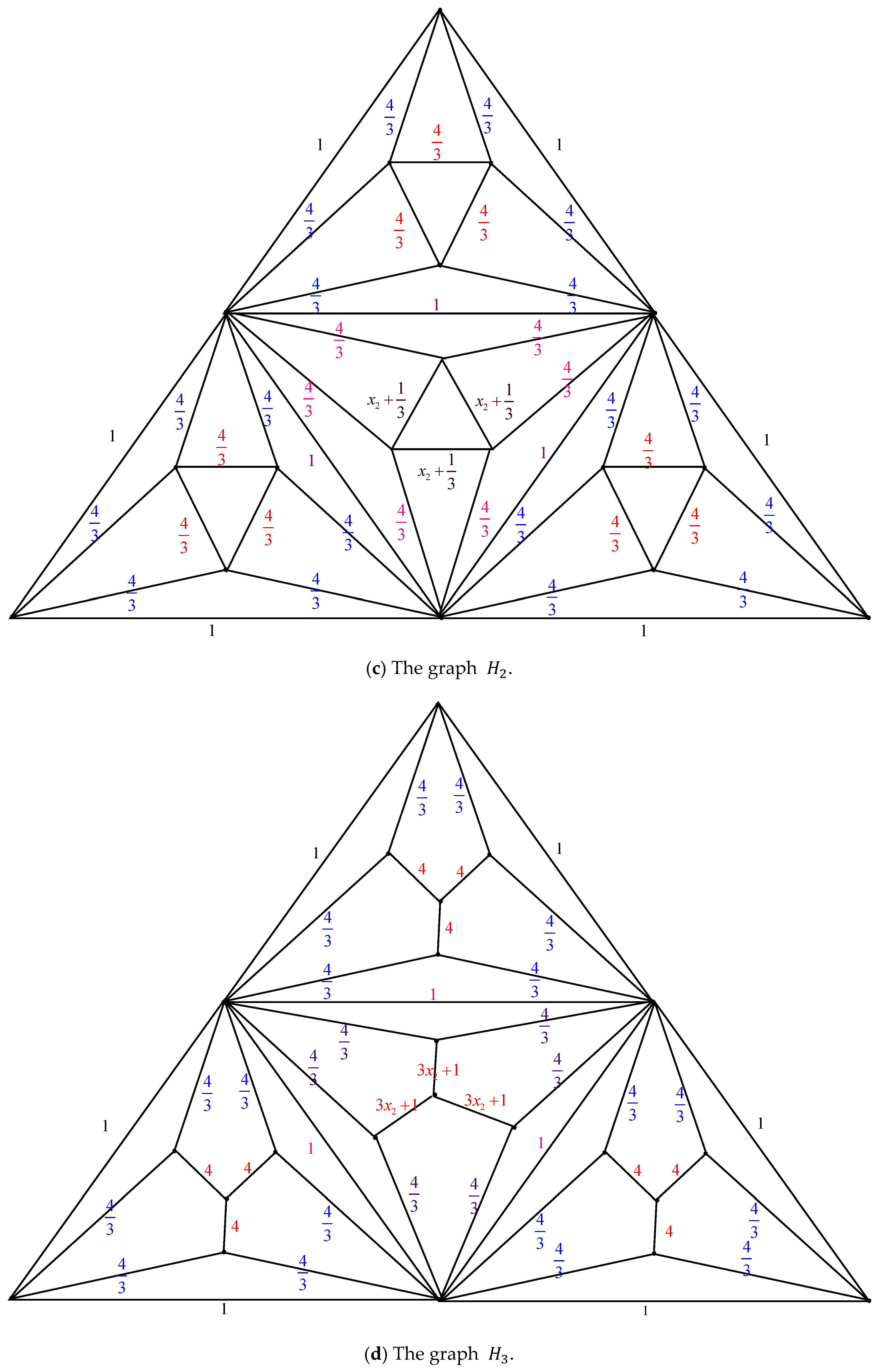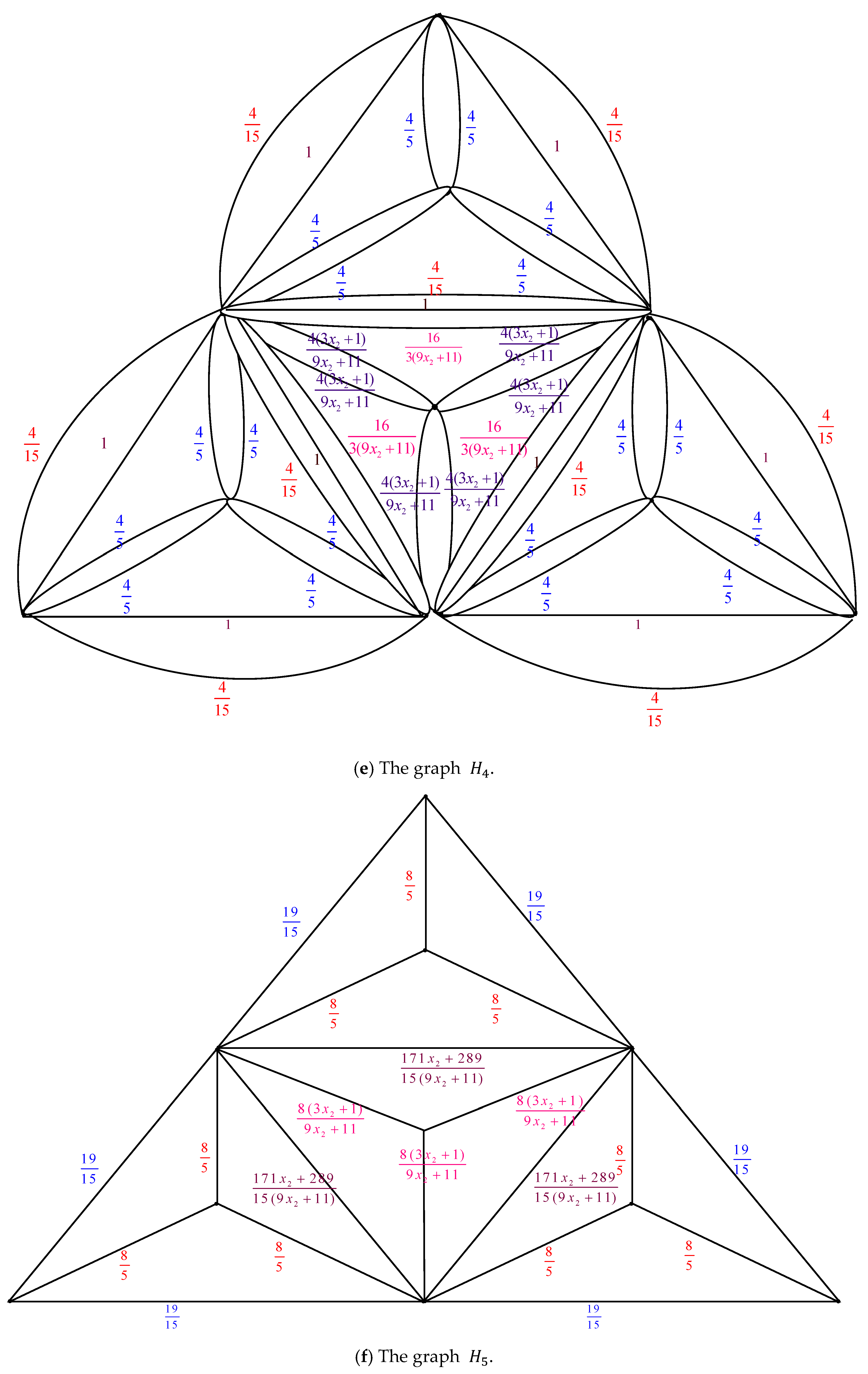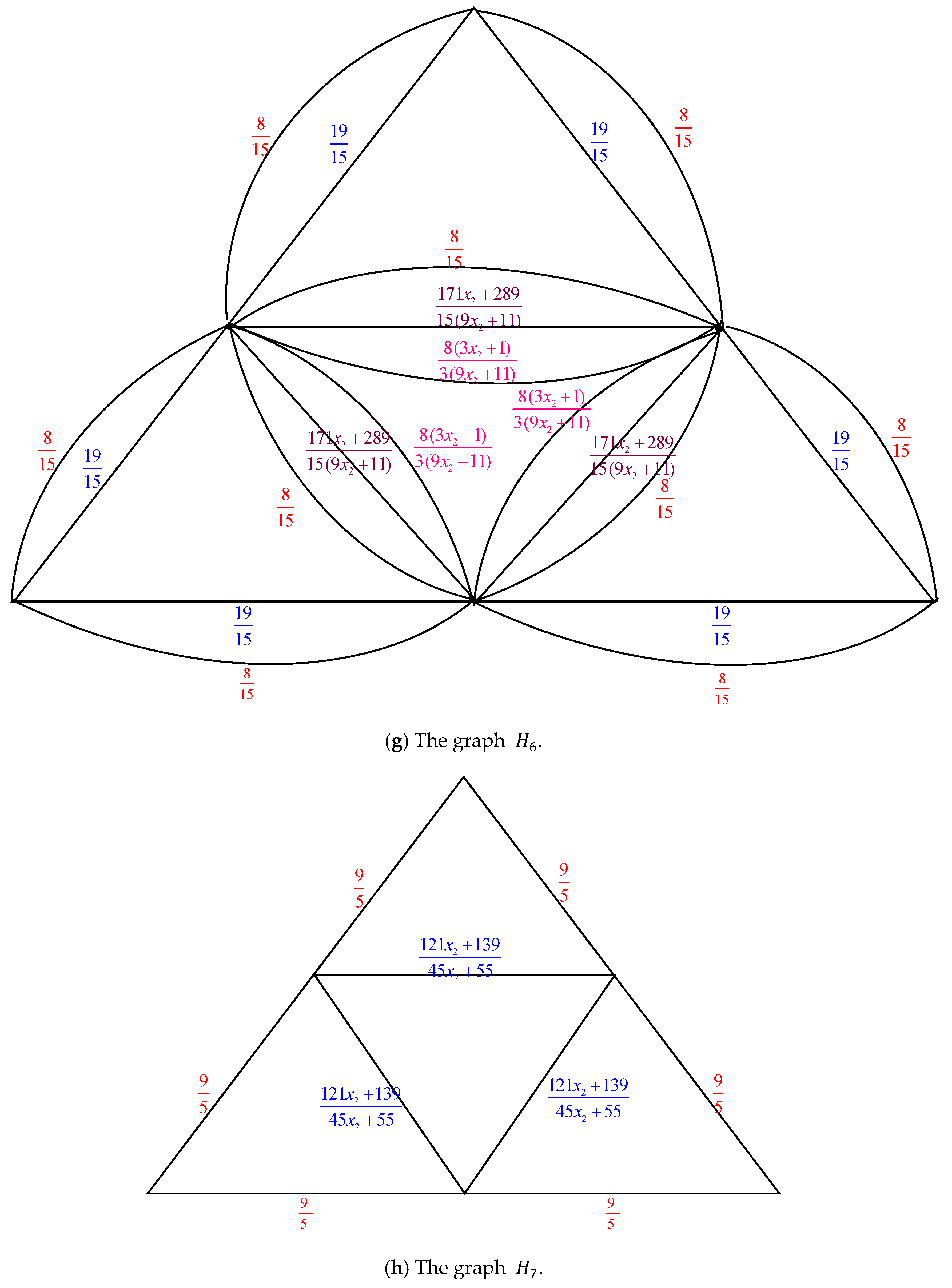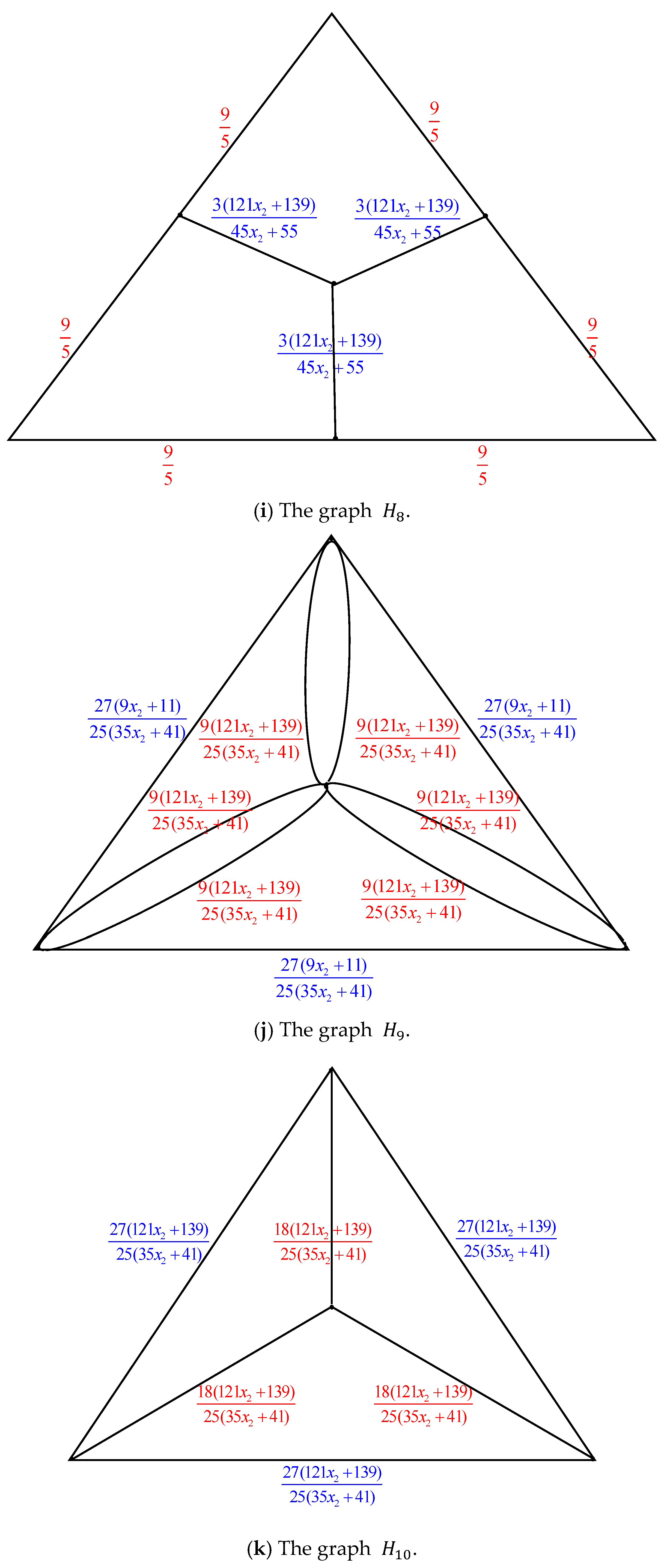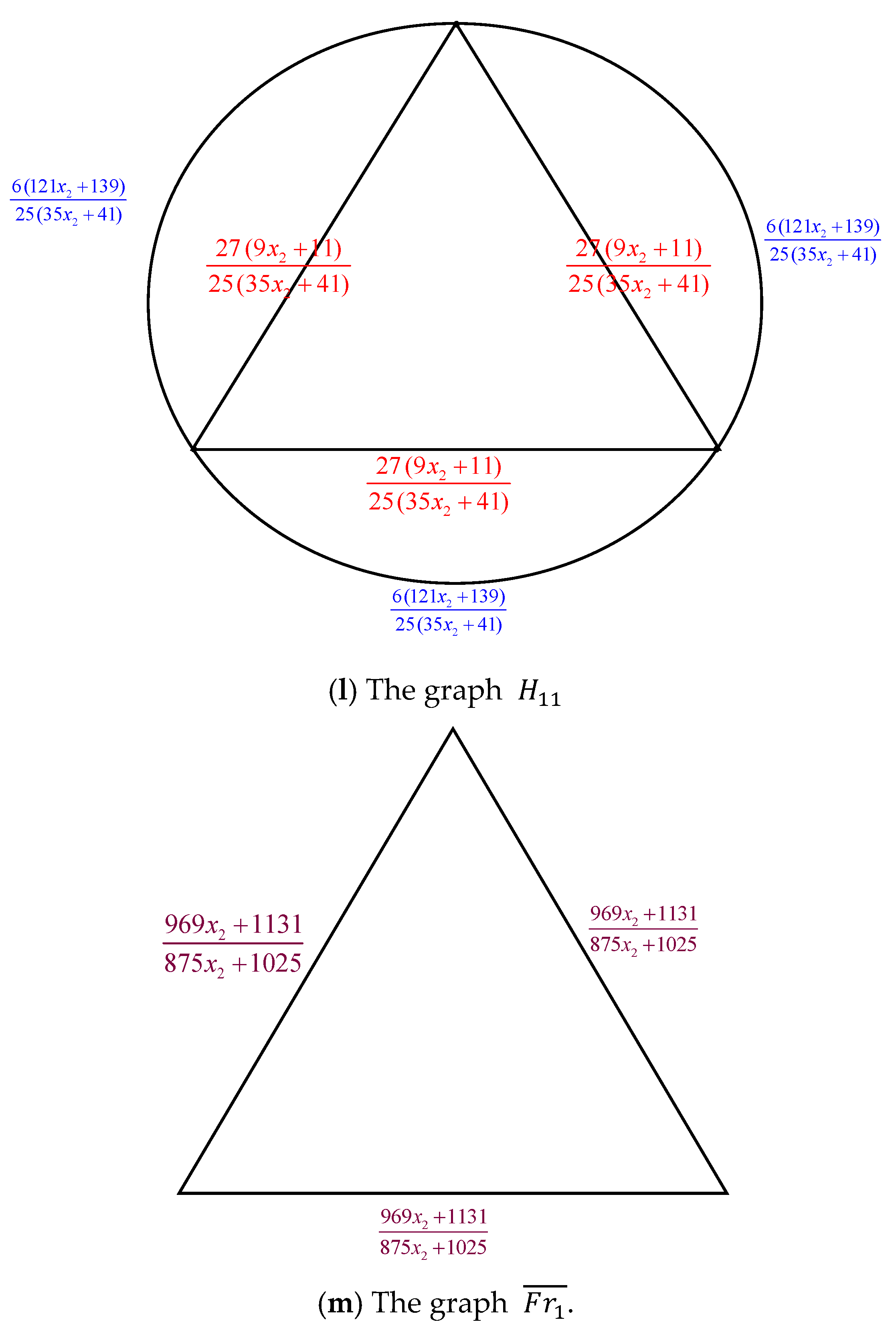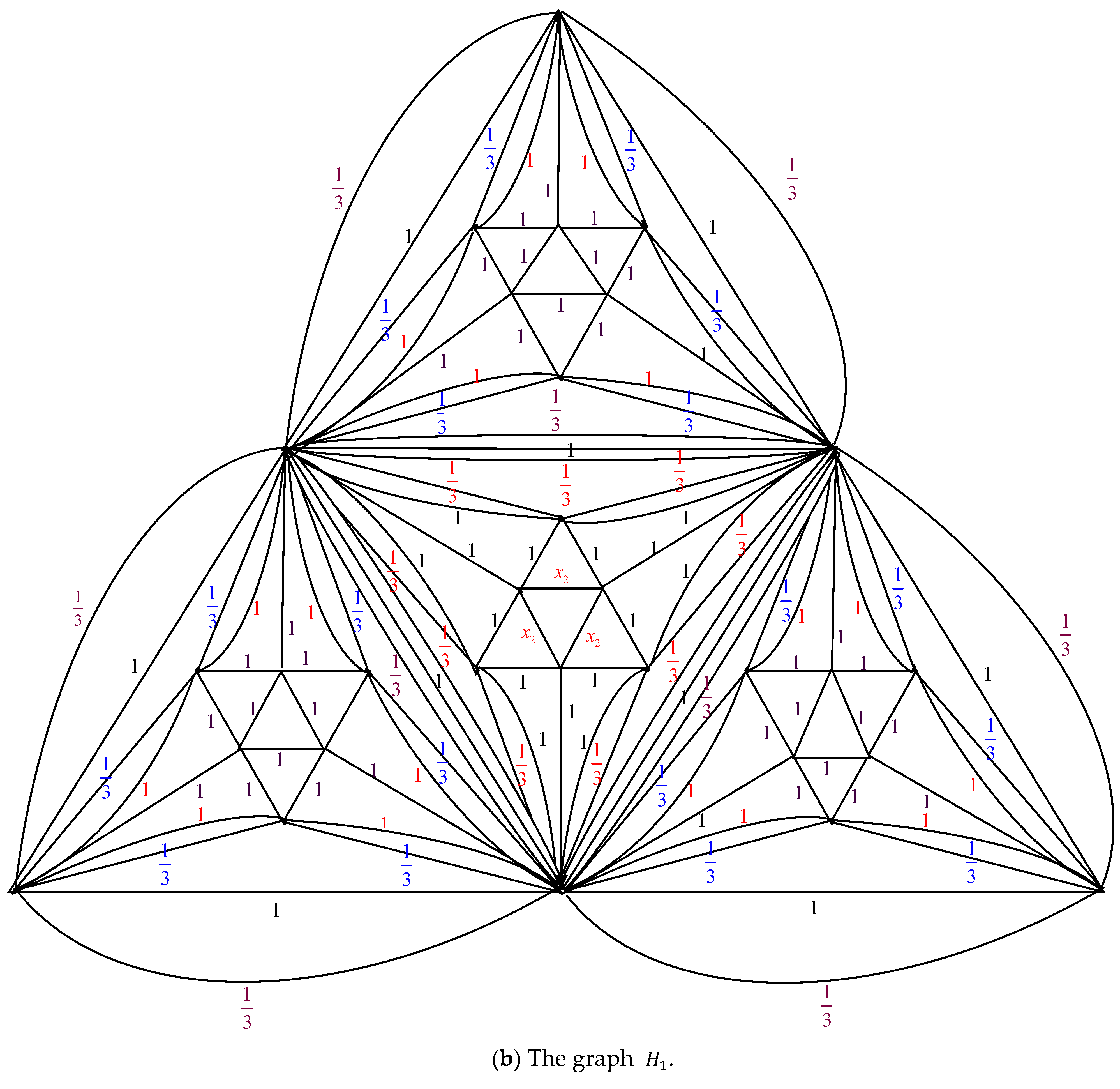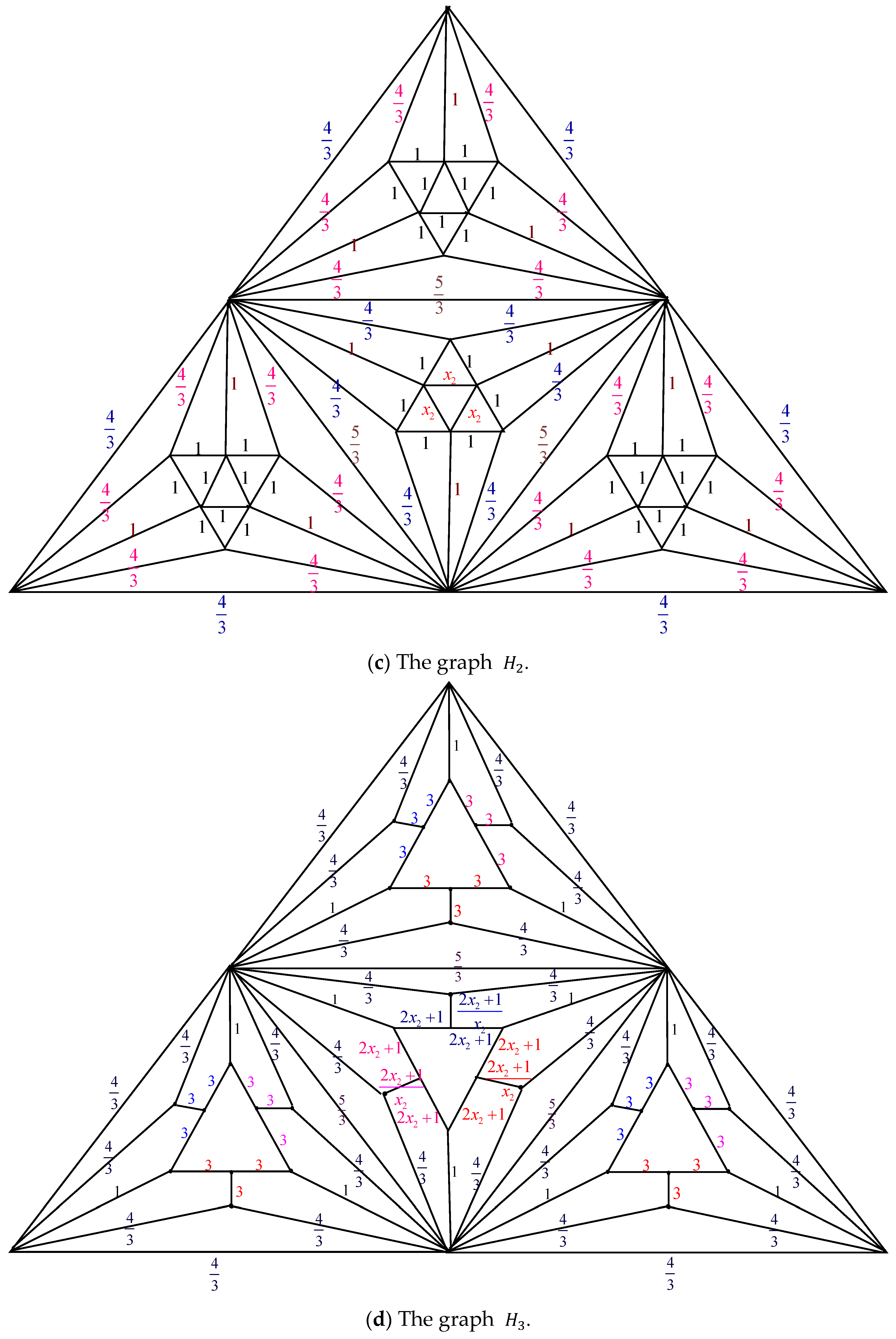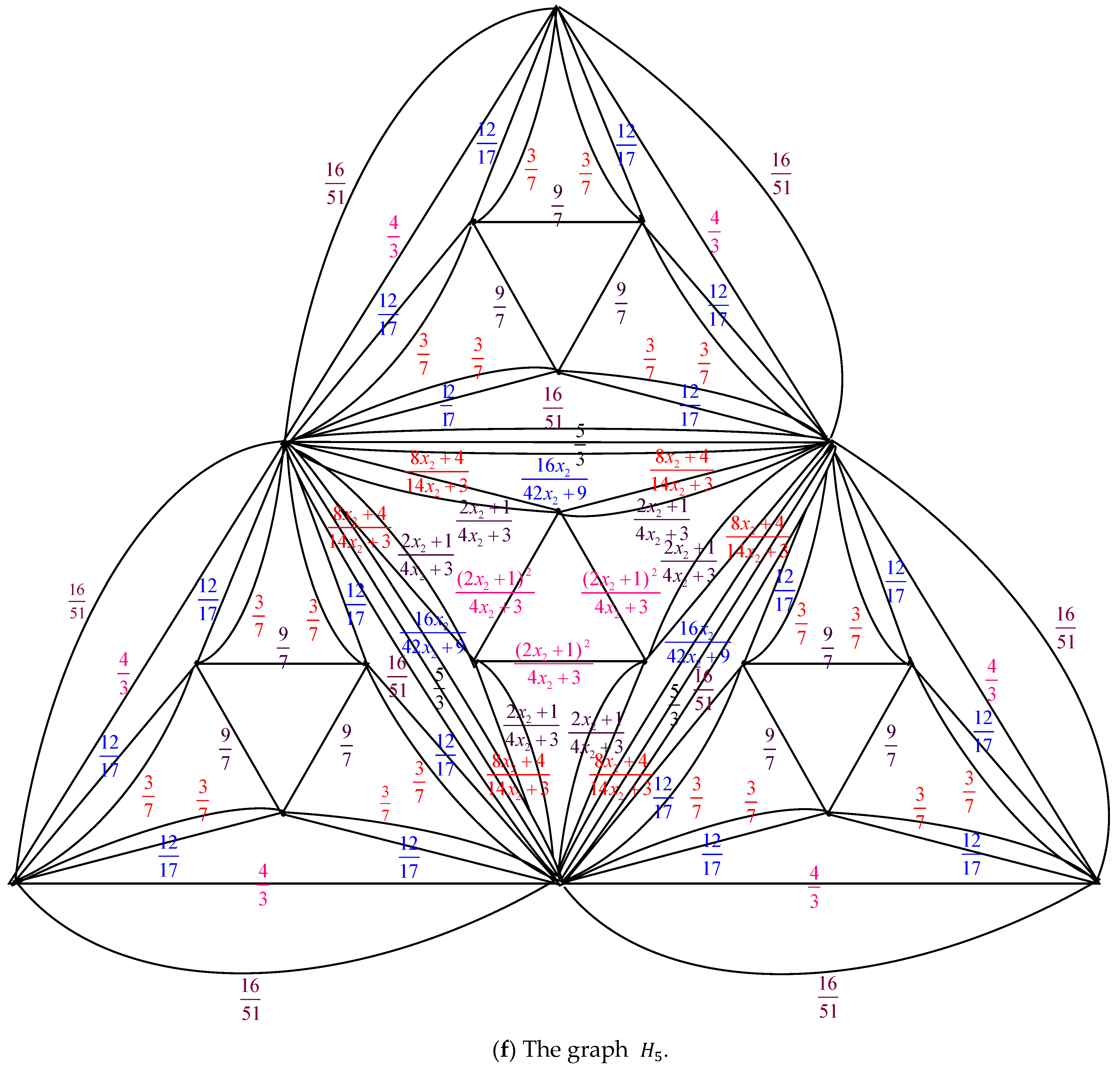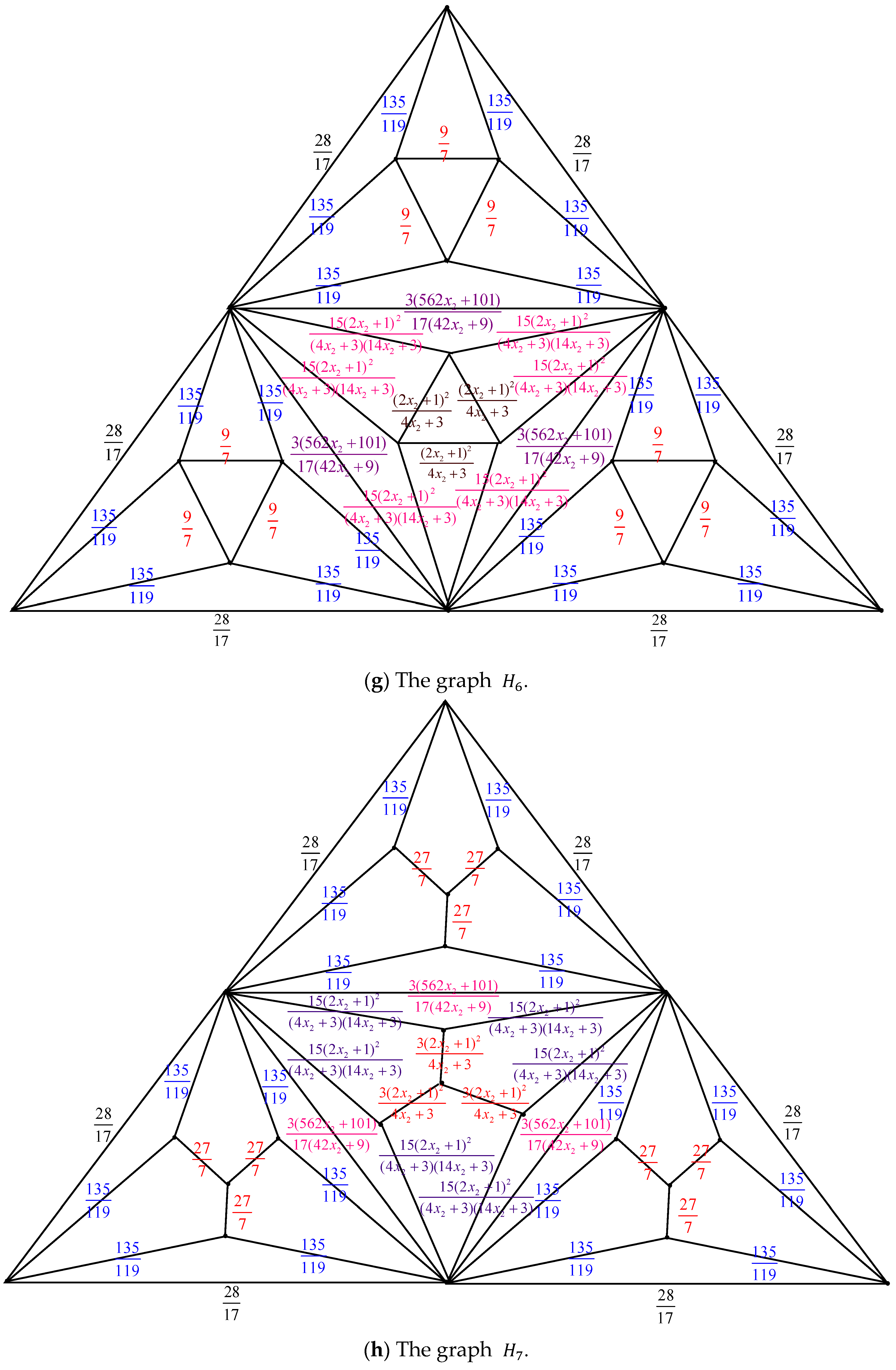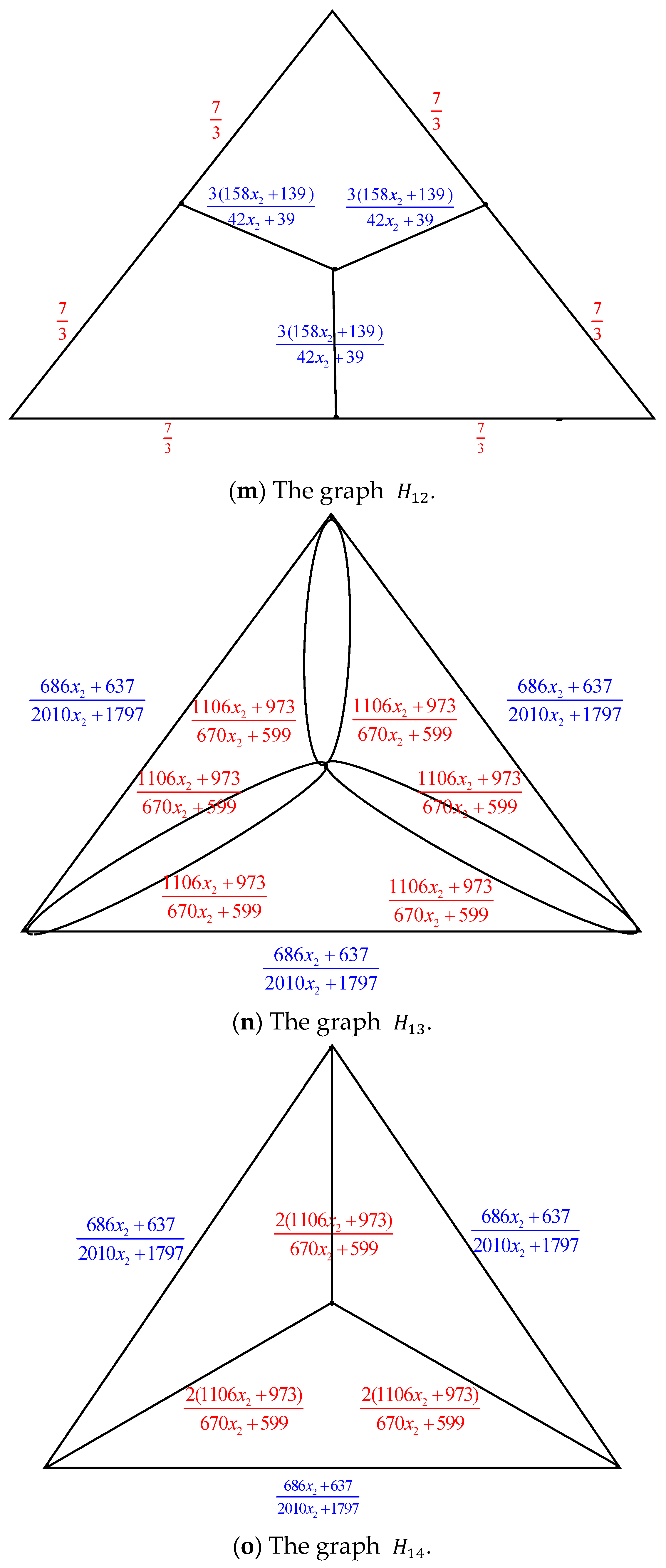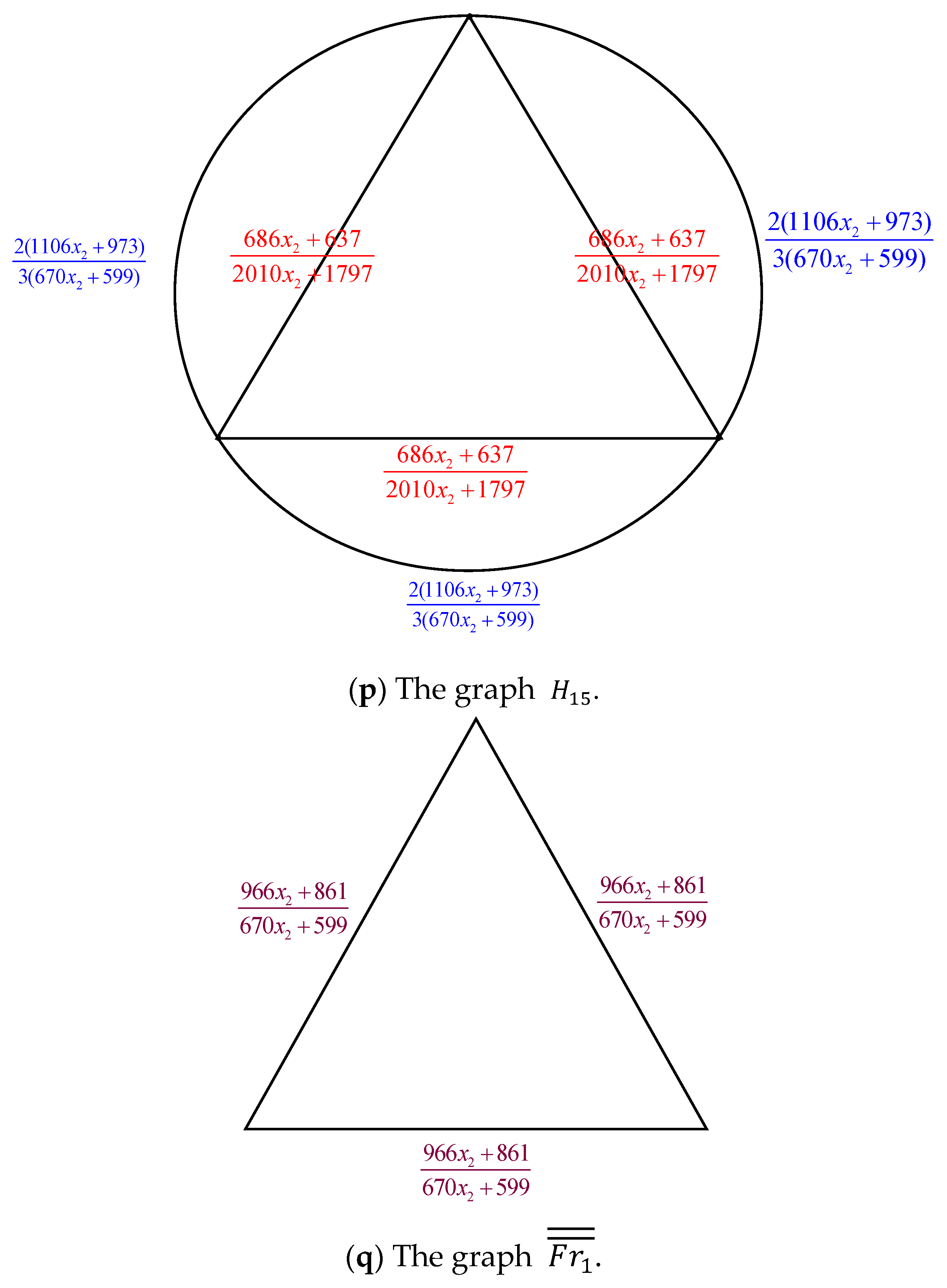1. Introduction
A spanning tree is a subgraph of an undirected, connected graph that contains every vertex in the original graph but only utilizes the fewest edges required to join them, creating a tree structure (i.e., no cycles). It basically connects every node in a network without forming unnecessary loops.
The complexity of is another name for the number of spanning trees , which is equal to the total number of different spanning subgraphs of that are trees.
Determining closed-form expressions for the complexity (number of spanning trees) in various graph types has garnered significant interest. Eulerian circuit counting [
1], network analysis techniques in psychological networks [
2], chemical isomer enumeration [
3,
4], and solving intractable issues like the traveling salesman and Steiner tree problems [
5] are some of the important applications of this field of study. It is also possible to identify the most complex graphs by examining various graph types, which have applications in network resilience [
6,
7].
A graph must have a spanning tree since every node in the network it represents needs to be able to communicate with every other node. Dependability can be raised by increasing the number of spanning trees.
A Kirchhoff classical result [
8] from 1847 can be used to determine the number of spanning trees for a connected graph
with
vertices. With
representing the adjacency matrix of
and
representing the diagonal matrix of its degrees, the Kirchhoff matrix is a characteristic matrix
, where
is defined as follows:
All co-factors of are equal to the number of spanning trees in the graph .
Another technique to calculate the complexity of a graph
is as follows: Let
represent the
matrix’s eigenvalues. Kelmans and Chelnokov [
9] demonstrated the following in 1974:
One common method for counting the number of spanning trees is the deletion–contraction strategy. This method is dependable for determining the number of spanning trees
in a multigraph
. This technique makes use of the fact that
where
indicates the graph that is produced by deleting an arbitrary edge
, and
indicates the graph that is produced by contracting an arbitrary edge
e [
10,
11]. Numerous works have focused on counting and maximizing the number of spanning trees for various graph families [
12,
13,
14].
Kirchhoff’s interest in electrical networks stemmed from the possibility that an edge-weighted graph, whose weights represent the conductance of the associated edges, may be thought of as an electrical network. It is possible to express the effect conductance between two vertices
as the quotient of the (weighted) number of spanning trees and the (weighted) number of so-called thickets, which are spanning forests that have exactly two components and the characteristic that each component contains exactly one of the vertices
[
15,
16]. Below are the effects of several simple changes on the number of spanning trees.
is the weighted number of spanning trees. Let
be an edge weighted graph and
be its electrically equivalent graph.
Parallel edges: The count of spanning trees, , stays the same when two parallel edges in with conductances of and are combined to form a single edge in with a conductance of .
Serial edges: is equal to times if two serial edges in with conductances and are linked to generate a single edge in with a conductance .
Δ-Y transformation: The number of spanning trees in , , can be computed as times once a triangle in with conductances , and is transformed into an electrically equivalent star graph in with conductances , , and
Y-Δ transformation is the process of converting a star graph in with conductances , , and into an electrically equivalent triangle in H with conductances , , and . The result is given by multiplied by .
2. Main Results
The Fritsch graph has nine vertices and twenty-one edges, making it a maximum planar graph. It is isomorphic to the triaugmented triangular prism’s skeleton. The Fritsch graph plays a crucial role in demonstrating flaws in Kempe’s attempted proof of the four-color theorem. The graph is notable because it highlights how Kempe chains, used in the flawed proof, can interact in a way that invalidates the color swapping strategy.
Creating a new structure from an old one is always the aim in mathematics. Graphs are another area where this is true, as a given set of graphs can be used to create many new graphs. The number of spanning trees of three new forms of pyramidal graphs made from the Fritsch graph and two of their related graphs, represented by
and
respectively, will be precisely determined in this work, as illustrated in
Figure 1.
2.1. Number of Spanning Trees of Pyramid Graph Created by Fritsch
The pyramid graph
is defined recursively using the graph
and the graph
(triangle or
) as follows:
is created by replacing the center triangle in
with
. See
Figure 2. According to this construction, the total vertices
and edges
are
and
,
. The average degree of
is in the large
limit which is
.
Theorem 1. The number of spanning trees in a pyramid graph, , created by the Fritsch graph series for , is determined by
Proof. By applying the electrically equivalent transformation,
is converted to
. Figure 3 illustrates the process of converting
to
.
The result of combining these thirteen transformations is
Additionally
where
The equation for its characteristic is
with roots
and
. These two roots can be subtracted from both sides of
, to obtain
Let
. Then by Equations (5) and (6), we get the following:
With the coefficients of
and
, represented by the symbols
and
, respectively, and using the formula
, we have
When Equation (10) is substituted into Equation (4), we get
where
and
. By the expression
and using Equations (8) and (9), we have
Equation (12) has the characteristic equation . Its roots are and .
The general solutions of Equation (12) are .
Given the initial conditions
and
we obtain
If , this means that is without any electrically equivalent transformation.
When Equation (13) is inserted into Equation (11), we obtain
Equation (14) is satisfied for
and
. Thus, the number of spanning trees in the pyramid graph
is determined by
where
The result is obtained by inserting Equation (16) into Equation (15). □
2.2. Number of Spanning Trees of Pyramid Graph Created by Related Fritsch Graph
The pyramid graph
is defined recursively using the graph
and the graph
(triangle or
) as follows:
is created by replacing the center triangle in
with
. See
Figure 4. According to this construction, the total vertices
and edges
are
and
,
The average degree of
is in the large
n limit which is 5.2.
Theorem 2. The number of spanning trees in a pyramid graph, , created by the related Fritsch graph series for , is determined by
Proof. By applying the electrically equivalent transformation,
is converted to
.
Figure 5 illustrates the process of converting
to
.
The result of combining these ten transformations is
Additionally
where
This has a characteristic equation
with the roots
and
. These two roots can be subtracted from both sides of
, to obtain
Let . Then by Equations (19) and (20), we get and
Using the formula
and designating the coefficients of
as
and
, we have
When Equation (24) is substituted into Equation (18), we get
where
and
. By the expression
and Equations (23) and (24), we have
Equation (26) has the characteristic equation Its roots are and .
The general solutions of Equation (26) are .
Given the initial conditions
and
, we have
If , this means that is without any electrically equivalent transformation.
When Equation (27) is inserted into Equation (25), we obtain the following:
Equation (28) is satisfied for
and
. Thus, the number of spanning trees in the pyramid graph
is determined by
where
The result is obtained by inserting Equation (30) into Equation (29). □
2.3. Number of Spanning Trees of Pyramid Graph Created by Graph
The pyramid graph
is defined recursively using the graph
and the graph
(triangle or
) as follows:
is created by replacing the center triangle in
with
. See
Figure 6. According to this construction, the total vertices
and edges
are
and
,
. The average degree of
is in the large
limit which is
.
Theorem 3. The number of spanning trees in a pyramid graph , created by the related Fritsch graph series for , is determined by
Proof. By applying the electrically equivalent transformation,
is converted to
.
Figure 7 illustrates the process of converting
to
.
The result of combining these fifteen transformations is
Additionally
where
Its characteristic equation is
, with roots
and
. Subtracting these two roots on both sides of
, we get
Let .
Then by Equations (33) and (34), we get
and
Using the formula
and designating the coefficients of
and
as
and
, we have
When Equation (38) is substituted into Equation (32), we get
where
and
. By the expression
and Equations (36) and (37), we have
Equation (40) has the characteristic equation Its roots are and .
The general solutions of Equation (40) are .
Given the initial conditions
and
, we have
If , this means that is without any electrically equivalent transformation.
When Equation (41) is inserted into Equation (39), we obtain
Equation (42) is satisfied for
and
. Thus, the number of spanning trees in the sequence of the graph
is determined by
where
The result is obtained by inserting Equation (44) into Equation (43). □
4. Spanning Tree Entropy
Once we have exact formulas for the number of spanning trees of the three pyramid graphs,
,
, and
, we can compute the spanning tree entropy Z, a finite number and an interesting metric defining the network topology. In [
17,
18], this is explained as follows: With reference to graph
,
Despite having the same number of vertices, edges, and average degree, the pyramid graph
has a higher entropy than the pyramid graph
. Similarly, even though the pyramid graph
has more vertices, edges, and average degrees than the pyramid graphs
and
, its entropy is lower. Additionally, the apollonian graph [
19], which has an average degree of 5 (entropy 1.354), has a lower entropy than all pyramid graphs
,
, and
.
The entropy of the graphs under investigation is also higher than that of the square grid graph, which has an average degree of 4 and an entropy of 1.166, and lower than that of the triangle grid graph, which has an average degree of 6 and an entropy of 1.62 [
20].

